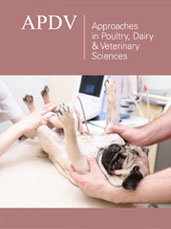- Submissions

Abstract
Approaches in Poultry, Dairy & Veterinary Sciences
Comparative Efficacy of Propofol, Alfaxalone, Midazolam-Ketamine-Butorphanol, And Dexmedetomidine-Ketamine-Butorphanol to Anesthetize Pekin Ducks
-
Open or CloseAmanda K Darbyshire1,2*, Gregory S Fraley3, Aidan Horvath1 and Jeff C Ko4
1Laboratory Animal Program, Purdue University, USA
2Department of Comparative Pathobiology, Purdue University, USA
3Department of Animal Science, Purdue University, USA
4Department of Veterinary Clinical Sciences, Purdue University, USA
*Corresponding author: Amanda Darbyshire, DVM, DACLAM, Assistant Director, Clinical Medicine, Laboratory Animal Program, Clinical Assistant Professor, Department of Comparative Pathobiology, College of Veterinary Medicine, Purdue University, Lily Hall of Life Sciences, Room 2114, 915 W. State Street, West Lafayette, IN 47907
Submission: April 23, 2025;Published: May 01, 2025

ISSN : 2576-9162Volume 10 Issue 1
Abstract
Gas anesthesia is the gold standard for producing general anesthesia in ducks; however, there are instances where it may not be appropriate. Injectable anesthesia is an alternative, but results can be variable, necessitating further research to determine proper dosing to achieve a surgical plane of anesthesia in this species. Our study investigated various doses of bolus versus Continuous Rate Infusion (CRI) of propofol or alfaxalone in Pekin ducks. Additionally, a one-time bolus of ketamine and butorphanol was compared with either dexmedetomidine or midazolam administered intravenously. Propofol was administered with an initial bolus of 10mg/kg, followed by additional boluses of 4mg/kg as needed, or alternatively, a 10mg/ kg bolus followed by a CRI of 24-50mg/kg/hr. Eight ducks received propofol, with four additional ducks used to explore higher CRI doses. Alfaxalone was administered with an initial bolus of 4-6mg/kg, followed by additional boluses of 2mg/kg as needed, or a CRI of 25.5-40mg/kg/hr. The MKB protocol involved a single dose of ketamine (8-15mg/kg), midazolam (0.5-3mg/kg), and butorphanol (0.5-2mg/kg). The DKB protocol involved a single dose of ketamine (10-12mg/kg), dexmedetomidine (0.02-0.03mg/kg), and butorphanol (0.5-1mg/kg). Statistically, there were no significant differences among the groups compared. However, clinically, a CRI of at least 45 mg/kg/hr of propofol produced the most stable plane of surgical anesthesia. Our findings are critical because the typical dose of 10mg/kg of propofol was insufficient to produce a surgical plane of anesthesia in this study. Further research is needed to optimize dosing protocols for injectable anesthetics in ducks.
Keywords:Anesthesia; Duck; Analgesia; CRI; Adverse effects
Abbreviations:CRI: Constant Rate Infusion; TAS: Total Anesthesia Score; MKB: Midazolam-Ketamine- Butorphanol; DKB: Dexmedetomidine-Ketamine-Butorphanol; ASC: Air Sac Cannulation
 a Creative Commons Attribution 4.0 International License. Based on a work at www.crimsonpublishers.com.
Best viewed in
a Creative Commons Attribution 4.0 International License. Based on a work at www.crimsonpublishers.com.
Best viewed in 







.jpg)






























 Editorial Board Registrations
Editorial Board Registrations Submit your Article
Submit your Article Refer a Friend
Refer a Friend Advertise With Us
Advertise With Us
.jpg)






.jpg)














.bmp)
.jpg)
.png)
.jpg)










.jpg)






.png)

.png)



.png)






